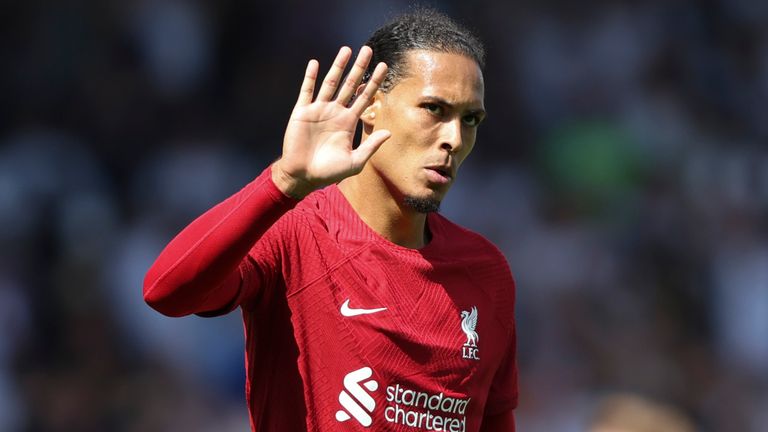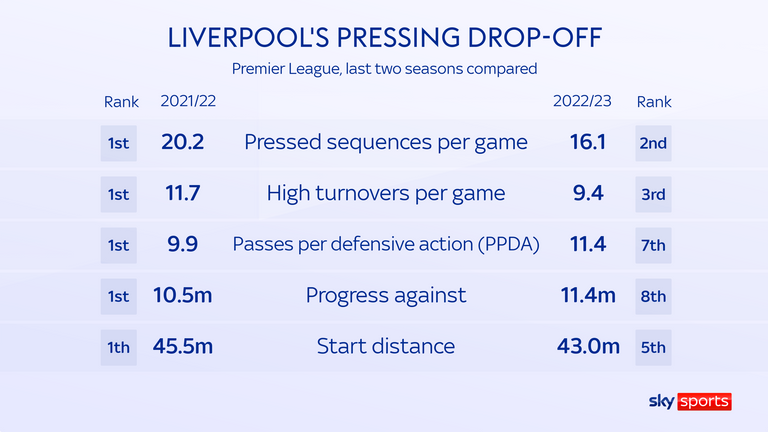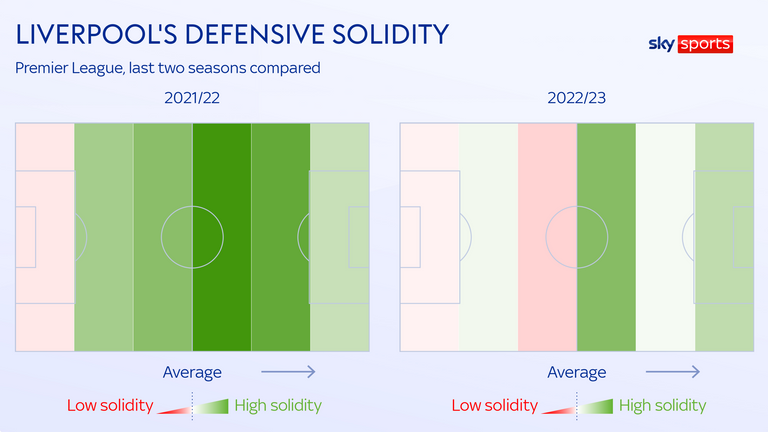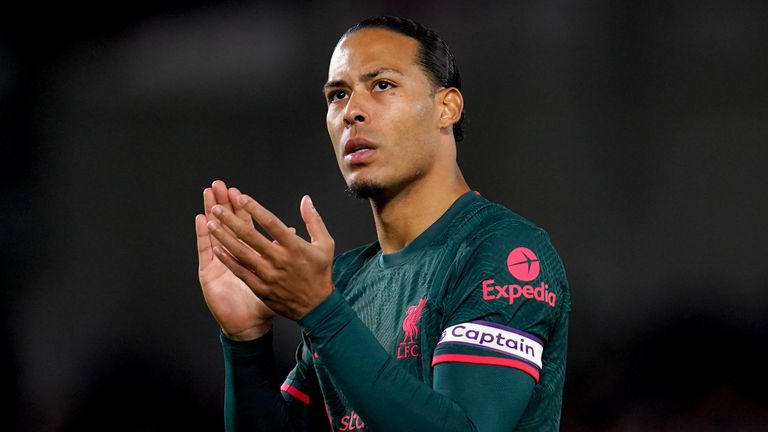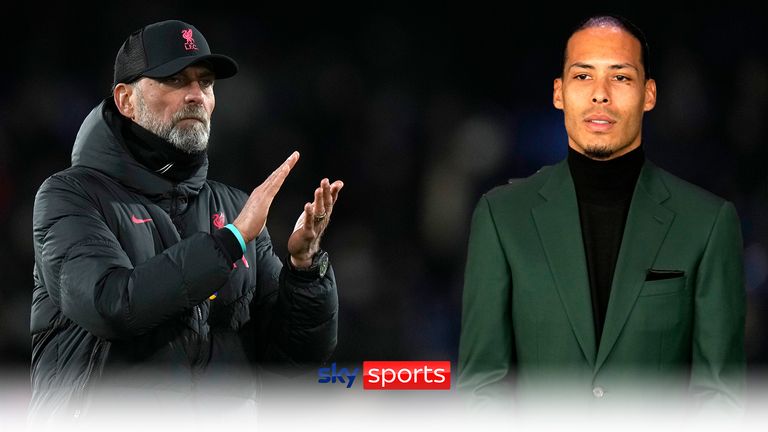[ad_1]
Virgil van Dijk’s poor performance in Liverpool’s 2-2 draw with Arsenal last weekend put him back under the spotlight and reignited the debate around his form.
The centre-back was partly at fault for both Arsenal goals, clumsily diverting Martin Odegaard’s pass to Gabriel Martinelli for the opener, and then losing Gabriel Jesus in the Liverpool box for the second.
His error-prone display was just the latest in a long line of them this season but what is behind his struggles? And do they represent a temporary dip in form, or are they evidence of a decline?
Sky Sports pundit Jamie Carragher leapt to his defence in the aftermath of the game, arguing that Van Dijk is a “far better” defender than Nemanja Vidic and describing him as “the best player in the league” along with Kevin De Bruyne over the last four seasons.
Carragher added that Van Dijk’s impact at Liverpool was the most profound by any centre-back in Premier League history and insisted the 31-year-old is simply having a “poor season” in his career, “like all players”, including Rio Ferdinand and John Terry.
Certainly, there can be no doubting Van Dijk’s impact following his £75m arrival at Liverpool from Southampton during the 2017/18 campaign. The next two years brought Champions League and Premier League glory. Van Dijk was key to the transformation.
He finished second only to Lionel Messi in the Ballon d’Or voting in 2019 and has been included in the PFA Team of the Year in three of the last four seasons, the only exception being the 2020/21 campaign, when a cruciate knee injury limited his involvement.
Van Dijk’s previous imperiousness makes his drop-off more alarming, but it is important to consider the context of Liverpool’s season as a whole when assessing his individual contribution.
Liverpool’s loss of intensity
There are problems all over the pitch for Jurgen Klopp and most of them stem from a significant collective drop in physical intensity.
After the gruelling efforts of last season, and with the profile of their squad ageing, the ferocious pressing that underpinned Liverpool’s previous success under Klopp has only been seen in patches.
As a result, a side that ranked top in the Premier League in most metrics related to pressing last season have seen their numbers slump dramatically in the current campaign.
According to Opta, Liverpool are registering fewer pressed sequences and forcing fewer high turnovers, their numbers dropping from 20.2 and 11.7 per game to 16.1 and 9.4 per game respectively.
Their average for opposition passes allowed per defensive action, a metric which measures the frequency with which a side attempt to disrupt their opponents’ passing sequences, has changed even more starkly, from just 9.9 last season to 11.4 now.
These issues are rooted in attack and midfield, where Liverpool are no longer pressurising opponents or regaining possession with the same effectiveness, but there are significant knock-on effects for those in defence, namely Van Dijk.
Liverpool’s opponents, no longer subjected to the same level of pressure on the ball, are finding it far easier to play through Klopp’s side. There are gaps to exploit, particularly in midfield. Those gaps have left Van Dijk and his defensive team-mates exposed.
This openness can be seen in Opta’s numbers for progress against, an advanced metric which measures the number of meters, on average, a side’s opponents progress upfield against them.
Liverpool ranked top among Premier Leagues sides for progress against last season, reflecting how Klopp’s side successfully stifled their opponents, but this term they have fallen to eighth.
Opta’s data for defensive solidity underlines the issue.
Liverpool are now defensively weaker than they were last season in all areas of the pitch, and the difference is most stark at the base of midfield, where the back four are no longer afforded anything like the same level of protection as they were.
The dwindling power of Liverpool’s press has forced them to defend deeper, their start distance, which is used to measure how far upfield a team begin their passing sequences, dropping from 45.5m last season, the highest in the division, to 43m in the current one.
It may only appear a minor change but in practice it is significant.
Van Dijk thrived when orchestrating Liverpool’s high defensive line but a side once famed for their compactness and aggression off the ball now find themselves forced onto the back foot and struggling to adapt to the changing circumstances.
Fatigue affecting Van Dijk
Liverpool’s issues in midfield and attack have undoubtedly contributed to Van Dijk’s struggles but they do not explain them entirely. The Dutchman must look at himself too.
Even lower-ranking teams such Bournemouth, Brentford and Nottingham Forest have managed to cause him significant problems this season and many of his errors have been basic ones, the repeated lapses of concentration causing his aura to fade.
Liverpool have felt the effects of fatigue both on a physical and mental level after the exertions of last season, when they contested every game possible, their pursuit of a quadruple running right until the final weeks of the season and ending in heartbreak.
For Van Dijk, though, those effects have been particularly acute and that is largely down to the sheer volume of games he has played.
Indeed, since the start of last season, only six outfield players across Europe’s major leagues have played more minutes in all competitions at club level, while only five have made more starts.
Van Dijk, though, is unique among them in the sense that he has racked up those 7,545 minutes and 84 starts on the back of a major knee injury which kept him out for most of the 2020/21 season.
Most players would be eased into action after such a lengthy lay-off but not Van Dijk. Instead, he played the first 16 consecutive Premier League games of the subsequent campaign on his way to making 51 starts in all competitions over the course of the season.
The heavy workload has taken a toll. “Coming back from the knee injury, I played all the Premier League games, because I want to be out there,” Van Dijk said last month. “But what caught up with me is that I played too many games at a time.”
His importance to Liverpool, even now, is such that he will almost always be called upon when available and the same is of course true at international level. Van Dijk is Netherlands captain.
The World Cup, during which he played every minute of his country’s run to the last eight, compounded his problems with fatigue this season, adding to his load and ultimately leading to a hamstring injury which presented another hurdle in his search for form.
“I could have also thought before the World Cup, ‘let’s rest a little bit in order to be ready’, but I didn’t,” he added last month. “I think going into the World Cup, having the World Cup, and then doing nothing for a week and coming back was maybe not the right decision.”
Van Dijk’s hamstring tear occurred on his third appearance for Liverpool in only eight days immediately after the tournament, where he had played five times in 19 days.
But once again he had to be thrown straight back into the Liverpool side after the subsequent six-week lay-off, starting eight consecutive games before missing the goalless draw with Chelsea.
His performance in their next fixture, against Arsenal, showed the need for a longer rest, but with Liverpool bidding to secure as high a Premier League finish as possible in the remaining weeks of the season, there seems little prospect of him getting it any time soon.
Van Dijk’s fate tied to Liverpool’s
Van Dijk is approaching the latter years of his career. At 31, and turning 32 in July, it may be the case that he is nearing the end of his peak. But it is worth noting that centre-backs are often able to extend their best years for longer than other outfield players.
Ferdinand and Terry, two of the best in Premier League history, were still playing crucial roles in title-winning seasons at 34 and both had played more games than Van Dijk at his current age. Thiago Silva, meanwhile, is still going strong at 38.
Van Dijk does of course have a serious anterior cruciate ligament injury behind him – the kind of injury that can have lasting effects – but his performances last season, when he was named in the PFA Team of the Year, represented a return to top form.
His statistical output shows no great change this season, either.
He is still making vital defensive interventions, still passing with the same precision over short and long distances, and still capable of producing the same physicality. In fact, tracking data shows he has clocked a higher top speed this season than he did in the last one. He may have looked sluggish at times, but the pace is still there.
Rather, his biggest problems right now are that his workload has left him jaded, a consequence, in part, of Liverpool fighting on four fronts for the duration of last season, and that the team around him is not functioning in the way it did previously.
His return to his best, therefore, depends on two things: whether Liverpool can, before too long, grant him the period of rest and recuperation he needs, and whether Klopp can successfully address the issues and imbalances evident elsewhere in his team.
It is surely too soon, then, to say Van Dijk is in a state of decline, or that he is incapable of returning to his previous level. But he cannot be expected to solve Liverpool’s problems on his own. Instead, his fate is intertwined with that of the collective.
Watch Leeds United vs Liverpool live on Sky Sports Premier League and Sky Sports Main Event from 7pm on Monday Night Football; kick-off 8pm
[ad_2]
Source link
